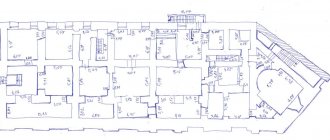Demolition of a house on the site involves not only the cost of demolition work - you will also have to pay for the removal of the resulting rubble. How much does it cost? People turn to Dachny Uyut Plus specialists with such questions almost every day.
We provide estimated prices for demolition. Because such complex work depends on many factors. Many people, having studied articles on the Internet, think that this is very expensive, but we dare to assure you that the prices in our company are always adequate, often below market prices, and very few companies in the Moscow region provide a comprehensive turnkey demolition and waste removal service.
Demolition or dismantling
The process of dismantling a house with a forklift
Sometimes you can come across the statement that demolition and dismantling are two completely different actions. Those who make this distinction usually draw attention to the fact that in the case of dismantling we have the opportunity to return the materials used to construct a given property or even entire fragments of it, while demolition is tantamount to the complete liquidation of the property. However, in practice, the terms “demolition” and “dismantling” are most often used as synonyms - this is how we will use them in our article.
Restoration of a wooden frame
Often, a wooden building is not completely dismantled, but only restored: some logs or beams, window blocks, etc. are replaced. In such cases, it would be useful to take care of replacing the old insulation (caulking) with more modern materials, namely wood sealants.
Also, when restoring old wooden houses, you should think about reliable protection of the wood: using various primers and impregnations, you can not only protect the wooden structure from all sorts of aggressive factors, but even return old darkened or blued wood to its original natural appearance.
Manual or machine demolition?
Demolition by hand sometimes pays off, primarily because the site owner can reclaim (and then sell or use for other construction) the building materials or parts of the house.
Unfortunately, you can only demolish by hand what is made of not very durable material. So in the case of a brick house, for example, it is demolished using machines - bulldozers, cranes, excavators. This method allows demolition to be completed in a few days, but machine demolition will cost you much less than manual demolition.
Types of houses for analysis
The largest percentage of houses being dismantled are centuries-old log houses. They no longer stand on ceremony with the material, they remove the roof, dismantle the logs (if necessary, saw them), load them into a container ship and take them away.
The second place is occupied by frame houses of the Soviet period. The cladding and insulation in such houses can be very diverse, and in several layers. The layers have to be dismantled one by one, and the volume of debris increases many times over.
Cost of building demolition - details, or what you pay for
Demolition of a house on a site with an excavator, Moscow region
The general concept of demolition costs includes the amounts you have to spend on more than just the demolition work itself. You also have to pay a company to haul the rest of the house to the landfill and dispose of it. In addition, the company carrying out the demolition assumes all technological obligations, and also monitors compliance with environmental and other standards.
Safety precautions
Demolition of a house is not only difficult, but also full of dangers, so following safety regulations is vital.
Basic Rules:
- Before starting work, it is necessary to inspect all structures that are subject to demolition. Particular attention is paid to their condition, how resistant they will be to collapse.
- Turn off all communications (gas, electricity, sewerage, water supply, heating).
- The head must be protected with a helmet and the hands with gloves.
- When dealing with glass wool, proceed only in full equipment - thick clothing, goggles, respirator, gloves. The skin of the face and neck also needs to be protected with either a helmet or a scarf.
- Nails from the boards are removed immediately. This will prevent someone from running into a nail.
- Order must be maintained even during the process of destruction - logs, boards, plywood and other building materials must be laid out according to type. This sorting will simplify subsequent work, and there will be no chaos on the construction site.
Demolition prices – what do they depend on?
How much you will pay for the demolition of a particular object depends on many factors. The most important of these is the cubic capacity (that is, volume) of the building. It consists of net cubic capacity - the volume of the building calculated along the external contour of all floors above and below ground (a number obtained by multiplying the total area of the building by the height of the floor) - and total cubic capacity.
The thickness of the building walls, obtained directly from the building material, is also important. For example, if they are up to 20 cm thick, the cost for their demolition is from 150 m2, and for walls made of concrete or reinforced concrete we will spend from 300 to 2000 rubles / m2. As for the height of the object - if the object, for example, is two-story, and its area is 100 m2, the company charges for its demolition an amount ranging from 35,000 to 62,000 rubles.
Other factors that determine the cost of demolition are:
- type of building structure;
- complexity of dismantling work;
- number of remains of the building;
- the distance to which the rubble remaining after demolition will have to be removed.
The process of demolishing a house, loading garbage with an excavator
When it comes to disposing of the remains of a house being demolished, you can confidently turn to our demolition specialists. To do this, you must sign an appropriate agreement, which will indicate the cost of demolition and garbage removal.
The distance from the site to a special container or landfill where construction remains and parts of the house being dismantled will be placed is the most decisive factor in determining the cost of removal.
The amounts spent on debris disposal vary greatly; in some cases they reach 1500 rubles/m3. In our country] demolition of a house with garbage removal[/anchor] costs from 500 rubles per cubic meter. There are no additional costs required from you. Contact our company, our specialists will advise you on all questions and nuances.
The difference between dismantling log houses and frame and panel houses
- Log house First, the roof is dismantled: the covering, planks, rafters and beams are removed. Next, the internal (non-load-bearing) partitions are dismantled. Then the ceiling is dismantled, doors and windows are removed. At the end, the load-bearing walls of the log house are dismantled. Logs are usually fastened together with metal rods (dowels). To disassemble the walls, each dowel must be pulled out. Then the log rolls away. This is how the walls are dismantled from top to bottom. At the very end, the foundation is dismantled.
- Frame house. First, windows and doors are removed. Then the outer cladding and ceilings are dismantled. Next, dismantling of the roof begins. First, the roof is removed, then the sheathing, joists, and ceilings. As a result, a frame of four walls remains, which can be easily separated. At the end, at the client’s request, the foundation is dismantled.
- Panel house. First, the doors and windows are removed and the outer cladding is dismantled. Then everything unnecessary is taken out of the house and dismantling of the interior decoration begins. Then the roof is dismantled, including the ceilings. Then the load-bearing walls are sawn. At the very end, the foundation is dismantled if the customer needs it.
Dismantling a private house is accompanied by the formation of a large amount of garbage, which can only be removed by specialized companies
When is the best time to start work?
As practice shows, dismantling it yourself is a fairly long process, so it’s better to start it in winter. At this stage, internal preparatory work is carried out (dismantling the casing, dismantling communications, etc.). By early to mid-spring, it will be just the walls and roof. Accordingly, if it is planned to build a new one on the site of an old house, it will be possible to start building it by the summer.
Dismantling of wooden houses begins with interior work
How to demolish a fence at the dacha
Each summer resident's fencing is significantly different, even from the nearest neighbor's. This could be a chain-link mesh on pipes, or maybe a stone fence on a strip foundation. Therefore, you should immediately decide for yourself why the fence is being demolished!
If dismantling a country fence is necessary because it is dilapidated, and the fence is completely demolished, then heavy equipment can be used. The sections are immediately removed, and the parts that served as the base are removed from the soil with a tractor or loader. If the fence needs to be moved and carefully reinstalled, then problems may arise. A very careful attitude to every detail will be required, especially if the fence is whole and not sectional.
- The wooden fence is disassembled element by element. First, the picket fence is dismantled, then the main strips and fence posts;
- The polycarbonate fence is dismantled starting from the front side, when the sections are removed after cutting off the fasteners. Further, in the same order;
- If the fence is stone or brick, you should start dismantling the fence from top to bottom, removing it little by little, immediately cleaning and stacking the building blocks.
How to demolish a playground
There can be many reasons for the demolition of children's playgrounds in the country, but the main one is the unsuitability of the structures or cladding. In this case, there is nothing to save here, except plastic parts, for example, the gutters of children's slides, protective parts of the railings, etc. The rest is demolished and goes into garbage or reuse at other facilities.
But we recommend that you carefully inspect such structures before demolition, because any playground is once a high-quality and durable structure. Therefore, if the external parts are worn out, which was the reason for the demolition, the internal frame parts may be in fairly good condition.
For example, the same load-bearing wooden beams, metal profile pipes, other parts of the base and frame.
FAQ:
1) Is it possible to save roofing sheets when dismantling a house?
Answer
It is impossible to preserve the slate; it will split during dismantling. A roof made of profiled sheets or sheet metal can be removed, but the sheets will be dented. We cannot provide the possibility of reusing this material.
2) Trees, bushes and flowers grow around the house. Can they be saved?
Answer
If the plantings are located close to the house, then most likely they will suffer. Even with the most careful disassembly of a wooden house, a free zone of 2-3 meters wide on each side is required for passage and carrying garbage.
3) We have a SNT with narrow streets, only a small truck can pass. How will you remove waste from a dismantled house?
Answer
In such cases, containers with a volume of 8 cubic meters are used. m. based on a ZIL car or an equivalent. This garbage truck can drive on any street intended for cars.
Material storage.
Why did I start with nails? The point here is not only about savings, but also about the convenience of subsequent storage. Boards with protruding nails take up about 3 times more space. And when you have only 6 acres with an old garden and buildings on them, you quickly begin to understand that you need to save space.
The time spent on pulling out a nail and bending it is almost the same.
You need to be careful when storing material so that you don’t have to drag boards and logs from place to place several times. It is necessary to think through all further actions during construction in advance.
For example, if excavation work is planned, then it is better to move the boards away from the future foundation pit so that they do not interfere with the work. In addition, it is better to choose a higher place for stacks. Then they will not end up in a puddle after rain or from melted snow in the spring. It is also advisable to put opaque material under them to prevent grass from growing under them. For this purpose I used roofing felt, which I removed from the walls and roof.
In addition, I used an old greenhouse as temporary storage. Many of the windows in it were broken, so to prevent rain from dripping on the boards, I also covered it with roofing felt.
Sawdust, glass wool and safety precautions. After dismantling the interior decoration of the attic, I went down to the first floor. I would like to note once again that at the first stage I did not touch the racks in order to prevent collapse, but only tore off the sheathing.
Sawdust and small shavings mixed with lime were used as insulation in the ceiling of the first floor. Adding lime is a very old and reliable way to get rid of mice. In any case, I did not find any traces of these annoying rodents in the sawdust. But they lived comfortably in glass wool...
The sawdust turned out to be dry, so I also decided to save it “just in case” - I poured it into plastic bags and put it under the roof. In the future they may be useful for their intended purpose, and if not, they will be used as fertilizer.
Glass wool was installed under the first floor sheathing. This created an additional problem, since it was not safe to work with, and after so many years it fell apart in the hands, which created unnecessary difficulties.
To avoid itching later, I took precautions. First, I put on clothes made of thick fabric and fastened all the buttons. He put a special helmet on his head, and two pairs of gloves on his hands (first fabric, and rubber on top). It must be said that the glass wool often pierced this protection, and then I suffered, trying to pull out the brittle splinters.
Secondly, I put on goggles and a respirator.
And thirdly, so that the glass wool generates less dust during disassembly, I first sprayed it with water, and immediately placed the extracted pieces of insulation into 120-liter plastic bags. This, in my opinion, is the optimal size in terms of weight and volume. However, if the glass wool is very wet, then it is better to use 60 liter bags, making several holes at the bottom with a nail for water drainage.
Here it is appropriate to say a few more words about safety precautions. The work of demolishing old buildings is often not without injury.
For example, when dismantling the roof, I was standing below on the stairs, trying to tear off the gable cornice board. But I didn’t calculate my strength, it came off and fell on my head, unprotected even by my cap. It’s good that the rusty nail only tore the skin on my head and didn’t stick into my head. But I still had to get stitches at the emergency room. Therefore, I strongly advise everyone who is preparing for such work to follow safety precautions!










